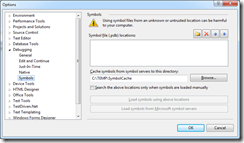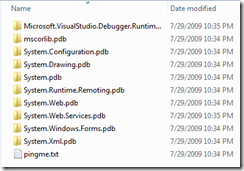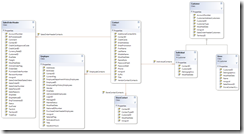On my current project I find that I’m working with Visual Studio on a VM that is in an isolated domain, which is making life interesting! One of those ‘interesting’ things was that Debugging in Visual Studio was horrendously slow! It would take several minutes to get to the first break point (first line of a unit test), then still be slow when accessing other parts of the code.
The slow part of the process was the loading of the symbol files for each of the referenced dlls, including those of the .NET framework. As it turns out Visual Studio actually loads the symbol files for the .NET Framework from the internet! So the delay is primarily due to timeouts which lead to an unbearable (read unusable) debugging environment. The good news is that there is a solution which is quite simple and easy to implement.
Solution
In order to dramatically improve your debugging you need to have Visual Studio use a cached version of the symbol files, as well as ensure its not trying to locate symbol files on slow network shares.
Here are the steps you need to fix the issue:
- Create a directory to store you locally cached symbols. Ie C:\Temp\SymbolCache
- Change the debug settings for loading symbols, via Tools|Options|Debugging|Symbols.

- (Option 1) Start debugging the code you want (on a machine that can access the internet; even if its slow) and have it sit on a break point. Then go back to the Symbols settings, where you’ll notice the button Load symbols from Microsoft symbol servers is now active (because that was obvious!). Click the button and you’ll see a popup windows indicating the download of the symbol files. After this is complete you can close out of this window and stop debugging. If you now check your Symbol Cache directory you’ll see you have a load of downloaded symbols (may vary depending on what you’ve referenced).

- (Option 2) If you have already done option 1 and you need to apply this to another machine, such as a team members machine, you can simply copy the files from one machine to the other.
- Depending on your environment you may also have one of two environment variables that need updating. Set either of these environment variables to the same location as the cache created in setup 2. The environment variables to change are _NT_SYMBOL_PATH or _NT_ALT_SYMBOL_PATH. The default setting for these are pointing to the Microsoft Symbols server. You can access the variables either via DOS (set command) or via the Advanced System Properties dialog in Windows.
One you’ve completed the changes you should see a dramatic improvement in your performance. Remember to check in Step 2 that you don’t have any non-existent paths or UNC paths defined as this will also slow things down.

Currently rated 3.4 by 9 people
- Currently 3.444444/5 Stars.
- 1
- 2
- 3
- 4
- 5
I've just released another sample for the Database Explorer API, this time using the built in features of Visual Studio 2008 (should work with VS 2005 with a download of the SDK). Visual Studio 2008 comes with a built in code generator known as T4. While the built in editing experience leaves a bit to be desired the free T4 editor by Clarius Consulting goes a long way to making it workable. If you download the editor, it indicates that the time bomb expires in Jan 1, 2008; this however isn't the case as they're still working on the next release.
This sample creates a fairly decent (not perfect by any means) set of entities which you can then easily drop on to a class designer and get a good feel for how your domain model looks. It has support for all but the recursive relationship type, which could be added as the API does support this. This sample is provided to show how much you can do with both T4 and the API in only a small amout of code. I've included a screen shot from the Adventure Works sample, which as you can see supports many relationship types. The sample download includes the results run against the AdventureWorks sample database.
To download the new sample visit the projects CodePlex page.
Remember to provide as much feed back on the samples and API as you can. Enjoy!


Currently rated 2.9 by 15 people
- Currently 2.933334/5 Stars.
- 1
- 2
- 3
- 4
- 5
I'm in the process of getting up to speed with DSL tools, and while there's a whole lot of info out there, at the end of a long day I'd prefer to watch a video on a new subject rather than pour over the written docs, but trying to locate all the video's can be difficult, and even more if you want to view them in the right order. Well this is my effort to make things a little easier. Unless otherwise stated these videos's relate to Visual Studio 2008 edition of DSL tools, as I discover more DSL video's I'll add them to the list. If you know of a good one I've missed, leave a comment and I'll get it added. More...

Currently rated 2.6 by 5 people
- Currently 2.6/5 Stars.
- 1
- 2
- 3
- 4
- 5
I went along to the .NET developers association in Redmond on Monday where Ken Levy demonstrated the extensibility tools of VS.NET 2008 (which also relates to VS 2005 to some extent). It seems that MS have decided to offer the VS 2008 shell license free! If you're anyone who's looking at providing third party tools (related or not to Visual Studio) and need a good IDE host, you've just saved yourself a bucket load of time. Also, it runs in two modes, integrated (merges with your instance of VS 2008) or isolated where it acts as its own (customisable too I was led to believe) IDE without the need for VS 2008. More...
-gets-serious!.aspx)
Be the first to rate this post
- Currently 0/5 Stars.
- 1
- 2
- 3
- 4
- 5